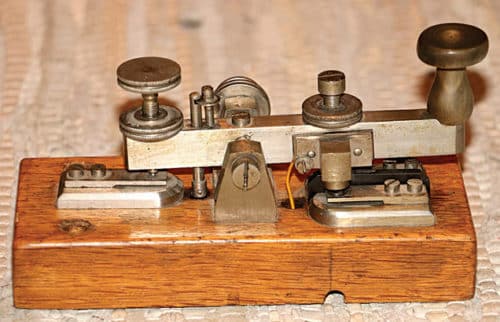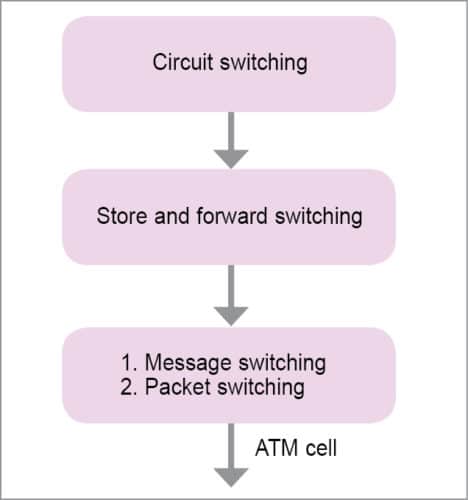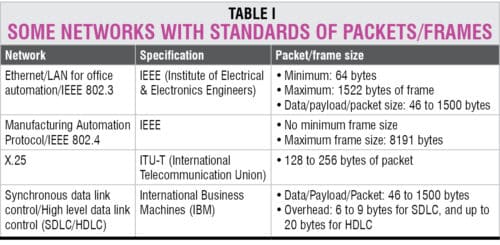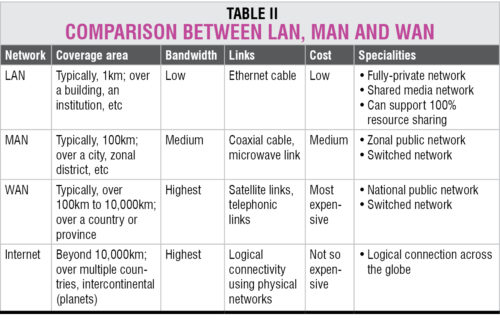According to Wikipedia, the Internet (or, interconnected network) is the global system of interconnected computer networks that use the Internet protocol suite (TCP/IP) to link devices worldwide. It is a network of networks that consists of private, public, academic, business and government networks of local to global scope, linked by a broad array of electronic, wireless and optical networking technologies.
The Internet can be defined as innovation plus integration. Innovation is best defined as not doing different things but doing things differently. The Internet perfectly carries out the exchange of information. However, it does so a bit differently. Communication engineering takes care of global communication for all services using one technology, known as the Internet.
The Internet is the integration of electrical and electronics communication engineering and data networking to amalgamate and support all services. It is a migratory technology of data or computer networking that branched from electrical communication engineering. All these streams follow nature. To best understand the development of the Internet and its future trends, it will help to understand these technologies in comparison with nature.
In this series of articles based on the Internet, we begin from the very first electrical communication engineering to data networking, before ending with an in-depth account of the Internet. In the process, major current and future developments of the Internet such as inter-planetary Internet, quantum Internet, mobile Internet, the Internet of Things (IoT) and other emerging issues will be taken up.
Electrical communication
“Man is the only animal that laughs and weeps; for he is the only animal that is struck with the difference between what things are, and what they ought to be,” said William Hazlitt, the English comic writer, in 1819.
When a baby is born, what it does at first is a form of communication, that is, weeping. This communication is natural voice communication. Natural voice (face-to-face) communication also involves video communication—as, when we speak, we see too. Besides, when we speak and see, we transmit data. Hence, this type of communication can also be called natural multimedia (voice+video+data/text) communication.
Any communication system must have three basic units: transmitter, receiver and transmission line. In natural voice communication, when we speak, our mouth acts as the transmitter and when we hear, our ear acts as the receiver. In between these two, air acts as the transmission line.
Natural voice communication has a few unique characteristics, as given below.
- It is instantaneous, with virtually zero delay between the transmitter and receiver. Thus, it is also real-time communication.
- This type of communication can be best described as “When I hear you, I feel you and I see you,” and so “When I speak with you, you feel me and you see me.” Thus, natural voice communication is more than just hearing (voice). It is seeing (video) and feeling (perception), too.
- It supports man-mobility. As we move, we can speak, see and feel, too.
- It is interactive.
- It is one where identity of the transmitter and receiver never differs from place to place. For example, your name does not change as you move from one place to another.
- It is fully wireless.
Natural voice communication is not without its limitations. It is essentially a short-haul form of communication. Its coverage area is small. Using this mode, communication beyond a few metres is not possible.
Many scientific and technological developments are aimed to overcome such challenges.
The telegraph: early long-distance text communication
Ancient civilisations of China, Greece and Egypt, for the purpose of long-distance communication, used drumbeats or smoke signals for exchange of information. As an improvement to such primitive systems, the semaphore was developed in early 1700s. In the semaphore system, a series of hilltops was used as movable arms to signal letters and numbers. Two telescopes were used to see the other stations. Later, improvements were made only in terms of increasing the coverage area of communication.
These ancient systems were susceptible to failures of line-of-sight between communicating stations, low visibility and bad weather, among others.
Subsequently, various other forms of communication were developed for long-distance communication to exchange information, ideas, thoughts, etc. A few examples are letters, books and newspapers.
Over the years, many systems of exchanges have been developed—including postal systems and newspapers/books delivery systems—basically as man-managed systems. All these developments attempted to achieve long-distance communication but could not attain any unique characteristic of natural voice communication. However, in 1790s came the opportunity to attain the desired goal with the invention of the first electrical communication, by the name of telegraph. On March 2, 1791, the first telegraphic message was sent.
Telegraphy is made of two words: tele meaning at a distance and graphy meaning to write. With this, long-distance communication of text messages was conceptualised. In fact, this was an improved version of a semaphore.
Discovery of radio communication paved the way for developing electrical telegraphy. Using semaphore networks, early telegraphy was carried out by French scientist Claude Chappe.
The credit for commercial telegraphy goes to Samuel Morse. A code known as Morse code was developed around 1837 for signalling of alphabets. Accordingly, text messages, as a series of codes, were transmitted between the transmitter and receiver using electrical signals.

Telegraph as the first long-haul communication system got systemised in postal communication. Post offices at a distance served as transmitters and receivers. But telegraphy, unlike natural voice communication, did not have features such as interactive, instantaneous, fully wireless, man-mobile, unique addressed and multi-mode communication. It connected only two geographical points at a time for service.
Electrical communication that started its journey with the telegraph is still marching ahead in multiple advanced forms.
Long-distance voice communication developed over the years
The next long-distance electrical communication is known as the telephone. The word telephone is made up of two words: tele meaning at a distance and phone implying sound. In a telephone, interactive voice communication is made over a long distance in real time (zero latency). In this system, telephone handsets act as transmitters/receivers (transceivers). These connect geographical points for the purpose of communication without any support for mobility.
All handsets have a microphone and an earphone. The microphone converts voice signal into electrical signal, and acts as the transmitter. Whereas, the earphone acts as the receiver. Electrical signals get transmitted over either wired or wireless mode, between two phones connected at a distance.
Alexander Graham Bell invented the telephone in 1876. The first call he made was to his assistant on March 10, 1876. His first words over his invention were, “Mr Watson, come here. I want to see you.”
The telephone operates via unique identification numbers that change from one location to another. Like a telegraph, the telephone connects geographical locations without the support of man-mobility. But unlike telegraph, it is interactive and supports real-time commination. It is therefore a step ahead of telegraph, but behind natural communication, as it does not support features such as multi-mode communication, fully wireless link, man-mobility and unique identification irrespective of location, among others.
Mobile communication—commonly known as cell telephony—was developed to infuse some sort of mobility in voice communication. To achieve this, geographic location-attached and portable handsets were replaced.
In mobile communication, portable handsets function using wireless (radio) links. Cellular or cell communication uses portable cellphones. The phones are registered in a geographic area called cell. Like post offices, each of which have a geographical area of operation, cells are connected to cover wider geographical areas for communication.
This achieved the target of mobility. But this is primarily machine mobility, and not man-mobility of natural voice communication. Unless you carry the cellphone with you, mobile communication is not possible.
Several global standards are used for cellular communication. A few of these are GSM (Global Standard/Systems for Mobile), IS 95, 200 (international standard) and UMTS (Universal Mobile Telecommunication Systems).
With advancements in information technology such as integrated circuit (IC) technology, cell communication is now equipped with transportation of text messages, data, video along with interactive voice communication over a distance. Long-distance, interactive and real-time voice, video, text and data (hence, multimedia) communication over wireless links is now possible with mobile communication.
However, challenges of unique identification of communicating entities and man-mobility for natural voice communication remain unresolved. With international roaming, of course, the issue of unique identification has been addressed to some extent.
Moving beyond cellphones, advancement of the Internet led to the support of multimedia real-time communication in many forms. The Internet is basically a data-carrying network. With the advent of VoIP (Voice over Internet Protocol), mobile IP and IPv6 (Internet Protocol version 6) technologies, the Internet can now carry multimedia over long distances, in no time.
The challenge of unique identification has been resolved further by the Internet. As an example, an e-mail ID can be used by only one unique person for communication. But, man-mobility still remains unresolved.
Personal communication network (PCN) was conceived, thereafter, to resolve the issue of man-mobility and unique identification for long-distance multimedia, interactive and long-haul communication. The idea first came about in the UK as a tool for a very-high-speed digital wireless cellular communication network with an intelligent system. Phones on the Move is a variation of personal communication, which is undergoing research in the UK. Development of PCN technology will pave the way for technology-enabled natural communication over long distance.
Data communication and networking
Stephen Hawking said, “We are all now connected by the Internet, like neurons in a giant brain.” This begs the question, why were we not connected by any of the predecessors of the Internet, such as telephony or telegraphy? The answer is, the Internet is a network that has converted BAD IT (where B stands for bursty, A for asymmetric, D for delicate and IT for insensitive to time) into an excellent network for all purposes.
In communication, all purposes cater to three basic services: voice, video and data. The predecessor of the Internet, namely, telephony, aimed to support voice and video communication. Telephony systems and networks cannot carry data. Characteristics of data are different from those of voice and video.
Data generation or arrival rates always come in bursts. Sometimes, data rates may be only a few bits per second (bps) and abruptly go as high as a few megabits per second (Mbps). In telephony, transport of voice signal is sent over a pre-established link between the caller and the recipient. The link established between the two remains dedicated for the entire period of conversation. No other potential user can use the link then.
Any pre-established link between the caller and the recipient can carry data of assigned/designed bit rate, which is fixed. Let us say, a link is of 1 kilobits per seconds (kbps). If such pre-established and dedicated link of fixed data rate is made to carry bursty data, two major engineering problems come up. First, when data arrival or generation is only a few bps, link utilisation is poor.
In the above example, if data arrival rate is one bps, utilisation (defined as data arrival rate/data service or link rate) will be 1bps/1kbps
This is extremely poor. From an engineering point of view, the solution is not at all cost-effective.
Second, when data arrival rate in burst is very high, say, 1Mbps, the link of 1kbps will not be able to carry data. Data will be lost in this case. In real life, it is like bursty traffic on road. When traffic is low, road utility is poor. When traffic is high, a traffic jam occurs.
In telephonic or voice communication, communication from the caller to the recipient, and vice-versa, is almost symmetric—50 per cent both ways, or 40 per cent on one end and 60 per cent on the other, and so on.
Unlike voice, data communication is mostly asymmetric. Flow of data in one direction is often more than that in other direction. It is like when you click on a link to download a file.
If the dedicated fixed-rate telephonic link is used to carry data, due to asymmetric nature of data, the link utility in one direction will be poor. Whereas, in the other direction it may be overloaded, causing loss of data. Data transport is, thus, unsuitable over a dedicated fixed-rate telephonic link.
In voice/telephonic communication, the caller and the recipient are intelligent entities, aka, human beings. Whereas, in data communication, communicating entities are machines, computers or other electronics devices. Due to human intelligence and perception, if there is any error or confusion in voice communication, the same is corrected by the communicating agencies. For example, when the caller says, “It is too big,” but it reaches the recipient as, “It is to big,” human perception and intelligence allow the recipient to correct it.
Correction of error in data communication is not possible, as end devices are machines. Thus, data transport is delicate. If a data in binary form, say, 10000000, from a source reaches with a single error at the left most bit to a receiver, it will be received as 00000000. This issue is addressed using due data correction strategy in networks, which is absent in telephonic networks.
No voice communication is perfect without being instantaneous. Telephonic communication is no exception. For example, a voice message saying, “I will go home tomorrow” having a three-day delay or latency is pointless.
That is not the case with data. It may not be a big deal if your bank statement reaches your e-mail address after three days of requisition. Transport of data with zero delay is a quality and not a necessity. Whereas, voice communication with zero delay is nature-specific and characteristically a necessity.
Data is insensitive to time, which means data transport may tolerate a delay, but voice cannot. This makes any data, while on transmission from source to destination, to be possibly chopped into pieces (each piece called a packet) and stored at intermediate nodes, to be transferred independently and subsequently, unlike a stream transfer of voice over a telephonic system.
To meet the characteristics of data, a branch of engineering has been developed for data transmission, giving rise to a specialised area called data networks. Data networks carry data of any base, such as decimal, octal, hex and so on.
Computer networks are data networks for carrying binary data made of 0s and 1s. Although technological and engineering aspects are almost the same, computer networks are an element of a set of data networks. The field of data networking began with the concept of data by packets. This gave rise to different switching techniques for data transport.
Switching techniques
Fig. 1 portrays the different switching techniques available for various transport technologies. Circuit switching fundamentally works with establishing a prior and dedicated link between source and destination for full duration of communication. After and when communication between parties is over, the said link is delinked for possible use of other potential users.

Circuit switching is appropriately used in telephony networks. In store and forward switching, messages are stored at intermediate nodes available between source and destination, and subsequently forwarded till the destination is reached. Pre-establishment of a dedicated link between source and destination is not necessary. Links are not dedicated and can be shared among all potential users.
Store and forward switching are of two types: message switching and packet switching. In message switching, the message is taken as one unit for transport between nodes. Message switching is appropriately applied to telegraphy and e-mail communication.
Message switching has a few limitations, as follows:
- When a message is long, junking of the link creates problems in communication.
- Due to limitation of buffer at intermediate nodes, a long message may result in either loss of data or buffer congestion.
- In a long message, if the link is junked, priority assigned transmission may not be possible.
These limitations are duly-solved with packet switching. In packet switching, messages or data are fragmented or divided into many parts, each called a packet. Each packet is enveloped with some overheads for packet numbering, error control, source address, destination address, start of frame, end of frame, priority assignment, synchronisation and so on, to make a frame. Packets/frames are made to traverse in the network from node to node, independently, to reach the destination from source via best possible/optimised shared link(s).
Packet switching is inherently fast switching. Due to packetisation (availability of packets that may move independently) and shared links between source and destination (availability of parallel links), different packets may traverse in different parallel paths. This results in lower transmission time.
However, overhead bits of frames/packets require more transmission time over original data. Thus, tradeoffs exist between parallel transport with overhead bits. Fewer number of packets amounts to possibility of use of fewer number of more parallel links, causing slower transport. More numbers of packets mean use of more parallel paths, resulting in faster transport. And more packets use more overhead bits, causing more transmission time, lesser of fast transport.
How many packets should be used and what should be the optimal size of each packet to derive maximum benefit out of packetisation? No specific engineering theory exists to answer these questions. Packet sizes are standardised for different data networks by different professional bodies. Table I has details on the same.

Packet switching is used in all networks, as shown in Table I. It is used to transport conventional data. Over time, there emerges a logical need to have a switching technique for all services, voice, video and data as multimedia services. In packet switching, packets are variable in sizes and relatively long. Variable packet sizes require higher processing time at transmitter (for making of frames with formation of overheads) as well as receiver (for removing overheads, rearranging packets in order, as packets may go out of order for transport over different available parallel paths, error checking, etc) sides.
Voice and video are time-sensitive services. Accordingly, packet switching was modified as asynchronous transfer mode (ATM) cell switching to make it applicable to voice and video, besides data. In ATM cell switching, packet size is fixed at 53 bytes with 48 bytes of data and five bytes of overhead. Due to a fixed packet size, node processing delay is minimised.
Further, the short size of a cell in ATM gives the benefit of availing more parallel paths and faster transport. This makes ATM (often known as very fast packet switching) an appropriate switching technique for multimedia services.
Packet switching is implemented in two modes: virtual circuit services (VCS) for huge data and datagram service (DS) for low data.
In VCS, logical virtual connection is pre-established for data transport between source and destination. All data of the session between source and destination follow the virtual link. But unlike telephony, the pre-established link is sharable.
In DS, the packet moves independently over available links between source and destination.
The motivation behind data networking was to connect geographically-distributed computing resources (standalone computers, terminals, printers, scanners, etc) through communication links (that may be wires, cables, optical-fibre lines, wireless links, etc) with a view to meaningful exchange of information. There are two primary goals: resource sharing and load sharing, so that costly printers, software and computing devices through networking can be shared. This results in cost-sharing among multiple users connected in the network, thereby making networking a cost-effective solution.
In case of huge load, standalone computers, when connected in a network, may use other computers for sharing the load. Thus, reliability and flexibility of implementing computing enhances through networking.
Data networks are classified in various ways. One of the ways is based on the routing mechanism of packets. In shared media networks (basically local area networks, or LANs), routing is made by media access control (MAC). In switched networks (metropolitan area networks, or MANs, and wide area networks, or WANs), packets are routed through intermediate nodes, often known as switching nodes.
Another means of classification of networks is based on geographical coverage areas of networks. Accordingly, networks are classified as LAN, MAN and WAN. See Table II for details.

The US military began the research and development of data networks in 1950s. But in 1969, researchers from California University, Los Angeles and Santa Barbara, Stanford Research Institute and University of Utah came up with a successful data network having a 50kbps connection link of four nodes in the four university locations. The network was implemented under Advanced Research Project Network (ARPANET), USA.
In 1973, Bob Metcalfe launched the Ethernet—IEEE 802.3-based LAN—as a discovery. This was a small step in data networking, for today’s big leap in the Internet. As a natural process of technological development, thereafter, MAN and WAN gave way to X.25 technology.
This article is dedicated to Leonard Kleinrock, who conceived the great idea of the Internet in his paper titled “Information flow in large communication nets” in the year 1961.
Read Part 2
Prof. Chandan Tilak Bhunia is PhD in computer engineering from Jadavpur University. He is also fellow of Institution of Electronics and Telecommunication Engineers, fellow of Institution of Engineers (India) and fellow of Computer Society of India.






